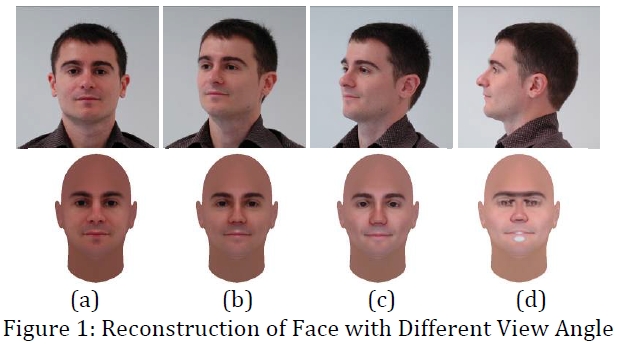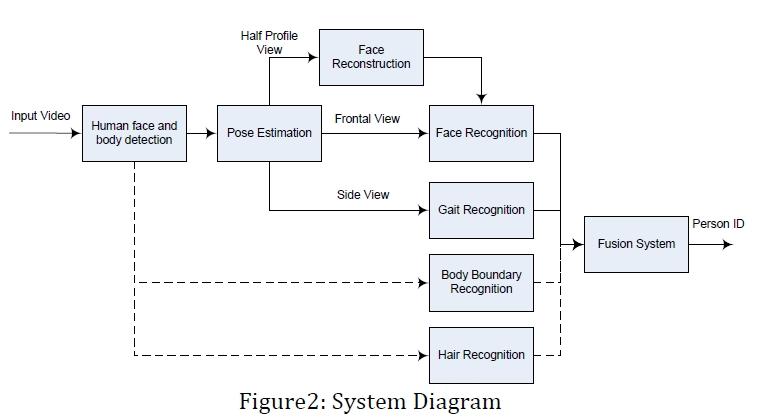 |
|
Background
|
Most biometric systems employed for human recognition require physical contact with, or close proximity to, a cooperative subject, such as fingerprint and iris. Far more challenging is the ability to reliably recognize individuals at a distance, when viewed from an arbitrary angle under real-world environmental conditions. Face and gait data are the two biometrics that can be most easily captured from a distance using a video camera [1].
Face detection and recognition algorithms have been very hot research topics in the last decades and a lot of robust and practical algorithms have been proposed and developed. However, the great success of these technologies rests on a very restrictive assumption, in which the face of interest are all assumed to have orientation that is passport photo alike. As a result, when an incomplete face appears in surveillance camera, recognition performance will be degraded. The impact of incomplete face can be alleviated by using face reconstruction [2-4] technique, which based on the theory that human face is horizontal symmetric, and loss of redundant information can be compensated. However, when only small part of face (less then 50%) can be observed, where some missing information could not be well recovered, the face reconstruction technique might not be able to reconstruct a reasonable face image for face recognition. As illustrated in Fig. 1(d), although the frontal face image can be reconstructed, it is still not very appropriate for face recognition purpose. |
 |
| Besides face, there are still other visual biometrics can be utilized to identify human individual, gait is a popular one of them [5-8]. Most current gait recognition algorithms rely on the availability of the side view of the subject since human gait or the style of walking is best exposed when one presents a side view to the camera. For face recognition, on the other hand, it is preferred to have frontal views. These complementary requirements motivate us to develop a system by integrating multiple visual biometrics. When human face is toward the camera, face recognition will dominate the human identification; in other case, when only small part of face or even no face is appeared, gait recognition will help to identify human individuals; and in intermediate state, fusion algorithm will enhance the performance of system. The overall idea is presented in the Fig. 2. |
 |
Is there more visual biometrics available for human recognition? Body boundary [9] and hair [10] are potential candidates. The discriminability of body boundary is not as strong as human face, and thus it is typically used to distinguish human and non-human objects. Hair style of a person, on the other hand, can vary from time to time, and therefore it is usually not adopted for human recognition. Still, we believe in short time interval with limited number of targets, those biometrics can also be included in fusion system for human recognition. We will carefully select visual biometrics and investigate the feasibility of integrating them in our future research.
There has been several independent research works on fusion recognition approaches. Kale et al. [5] present a gait-recognition algorithm and a facerecognition algorithm based on sequential importance sampling. The database contains video sequences for 30 subjects walking in a single-camera scenario. For face recognition, only the final segment of the database presents a nearly frontal view of face, and it is used as the probe. The gallery consists of static faces for the 30 subjects. Basically, they perform still-to-video face recognition. Zhou et al. [8] propose a system which combines cues of face profile and gait silhouette from the video sequences taken by a single camera. It is based on the fact that a side view of a face is more likely to be seen than a frontal view of a face when one exposes the best side view of the gait to the camera. The data are collected for 14 people with two video sequences per person. Even though the face profile in the work of Zhou et al. is considered to be reasonably sufficient, it only contains shape information of the side view of a face and misses the intensity distribution on the face.
The proposed project is distinct from other related researches, in following aspect:
1) Its face recognition module based on previous ITF-sponsored project, which transform face with arbitrary pose into frontal view for recognition, and is more sophisticated than the face recognition approach in aforementioned systems.
2) In addition to gait, more visual biometrics will be included in this fusion system to improve the recognition performance and handle the case of no face appearing. |
|
|
|
|
